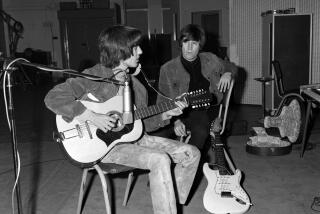Motor Maestro Plays a Different Tune
For Archimedes, it was his bathtub.
For George Wilson, it was his cluttered auto repair shop in Meiners Oaks.
That’s where he first realized he could coax notes from old carburetor parts and blown pistons. It may have been the first time anyone saw the musical possibilities lurking in the innards of old American cars. All it took was a visionary with a trombone mouthpiece and some time on his hands.
Maybe after George is gone, a plaque will go up: “Site of George Wilson’s auto shop,” it might read. “It was here that a man proved art is where you find it, if only you care to look”--and listen to a man pour his soul into “Getting Sentimental Over You” on a two-barrel Holley carburetor.
If World War II hadn’t intervened, Wilson may have gone on to fame playing the trombone instead of the carburetor.
He took up the instrument in high school but set it aside after he was drafted. At 40, he hauled it out again.
“The feeling just kind of came on,” said Wilson, a plain-spoken man with a nervous laugh and a dry wit. “I had to do it.”
Now 74, he wouldn’t discover his true medium for another two decades, when a friend gave him a cow horn. In one of those moments for which there is no adequate explanation, Wilson attached one end of a 2-inch length of fuel hose to his trombone mouthpiece and the other to the horn. In short order, he made that cow sing.
With rising excitement, he applied the same apparatus to a crankcase funnel.
“Oil rolls in,” he said, “and music comes out.”
Then he used it on a plastic cup, on a thermostat housing from a ’36 Chevy, on a Model-T horn, on ancient cylinders and rusted-out automotive whatnots. Each had its distinctive pitch and resonance and tone. Some of these experiments were successful; others--like the attempt to squeeze baritone notes from one of those big yellow cones that say “Wet Floor”--were not.
The sound is difficult to describe, but if you think of Betty Boop cartoons and singing waiters and Depression-era musicians on a bus crossing the freezing prairie, you might come close.
I asked Wilson how he could tell which of all the thousands of items packed into his garage might make a fine instrument.
“Basically I look for something with a hole in it,” he said.
*
At his repair shop--”I specialize in older American iron,” he says--Wilson presides over a one-man museum.
Fan belts and baseball caps hang from nails in the rafters. Plastic dinosaurs--gifts from customers grateful for Wilson’s knack with vintage cars--roam every counter. Grime-coated parts catalogs are stuffed into shelves, and the antlers from the first deer Wilson ever shot--the skull fell apart a few years ago--adorn a wall. A tool-company calendar features a pretty blond draped over a yellow racing car. It’s been tacked up for 11 years.
“I seem to not throw away knickknacks,” said Wilson, who still drives the Plymouth wagon he bought in 1950. “I’ve got 41 years of knickknacks here.”
A microphone sits tucked in a corner, along with a rhythm machine. When the spirit moves him, Wilson rigs up a funnel or a wrench socket or a carburetor housing and plays his heart out.
His first public performance was at a Ventura club about 10 years ago. Sitting in with a short-lived group called Live Meat on the Moon, Wilson became the first man in history to play “The Sheik of Araby” on the No. 3 piston from a ’62 Chevy.
Since then he’s played here and there, but demand for his services at bar mitzvahs and weddings has not been high. These days, he plays mainly for himself and select customers. His wife isn’t crazy about George’s calling. And his hunting pals have tolerated his instruments in camp in much the same way they might tolerate a militant vegetarian.
But for a visitor who expresses the mildest interest, he’ll do it all--from mostly forgotten tunes by the Hoosier Hotshots to Willie Nelson songs. I heard him do the Duke Ellington classic “Don’t Get Around Much Anymore” on a wheel cylinder from a 60-year-old Chrysler and “Tiger Rag” on a battered miner’s funnel that his prospector brother Bob had used in Nevada.
Sometimes, Wilson will pull up a stool and analyze tapes of his past efforts.
He was doing just that when I asked him to explain the dirge-like tone he struck on his taped rendition of “The Birth of the Blues.”
“I don’t know,” he told me. “Sometimes I would do this in the evening before going home--and after one or two beers, well, it just got kind of slow.”
Steve Chawkins is a Times staff writer. His e-mail address is [email protected].







